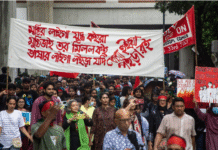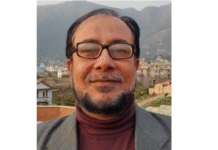By Pankaj Mishra
To an Indian who grew up in the 1970s and ‘80s, the sights of Dhaka, Bangladesh, seem to belong to a past that Indian metropolises have mostly outgrown: exuberantly battered buses, unpainted buildings, pavement book vendors with faded posters of Rabindranath Tagore and Karl Marx as well as the Rolling Stones, and pitch darkness on the unlit streets and squares where rural migrants congregate in the evenings. The countryside still feels closer here than in Kolkata or Mumbai.
In recent years, Bangladeshis have suffered the brutality of security forces and massive environmental destruction. For months now, the news from the world’s seventh-most-populous country has been dominated by the fractiousness of the country’s main leaders, the trial of men suspected of war crimes during Bangladesh’s war of liberation in 1971, and the slavery-like conditions of the country’s garment industry.
I arrived in Dhaka during one of the many recent strikes called by the opposition party, the Bangladesh Nationalist Party, against the ruling Awami League. The shutdowns, imposed through force, seemed economically ruinous, damaging small businesses the most; they resolved nothing. At first glance, Bangladesh seemed, like many countries in its neighborhood, to be struggling to find a way forward.
Irreconcilable Differences
Shackled by irreconcilable differences between political personalities, the country offers yet another instance of a fledgling democracy undermined by an undemocratic winner-takes-all attitude among its leaders. Bangladesh does have its innovators, such as Muhammed Yunus, the pioneer of microcredit. The banking system seems more responsive to the poor majority than in it does India. Bangladesh also does better than its much richer neighbor in almost all indicators of the United Nations’ Human Development Index.
But the benefits of trade liberalization — and, in general, Bangladesh’s integration into the global economy — have been more limited than previously expected. Certainly, the country’s economic modernization, which seems necessary to pull tens of millions out of destitution, seems to be proceeding much too slowly.
India is building a security fence on its border with Bangladesh, ostensibly to keep out Bangladeshi immigrants whose presence provides fodder to Indian demagogues. Meanwhile, a weakened state has ceded, often opportunistically, its responsibility to mitigate poverty and improve social infrastructure to such nonstate actors as aid organizations, corporations, security companies, consultants, and various domestic and international nongovernmental organizations. Bangladesh is one of the most NGO-ized countries in the world.
What happens next? Can Bangladesh join the modern world with its weakened governance, dysfunctional political system and uneven economic growth? An absorbing new book, “Boundaries Undermined: The Ruins of Progress on the Bangladesh-India Border,” seeks some answers in Bangladesh’s earliest attempt at modernization.
The author, a Bangladesh-born social anthropologist named Delwar Hussain, describes the strange aftermath of the Khonighat Limestone Mining Project. Situated near the Bangladeshi district of Sylhet and the Indian state of Meghalaya, Khonighat was one of the spectacular projects of national modernization that every postcolonial country once boasted of. India, for instance, had the Soviet-built Bhilai township — designed, as one early resident, the poet and essayist Arvind Krishna Mehrotra, wrote, “by a pencil stub and a six-inch plastic ruler.”
The grids were no accident. They spoke of the rationalization and bureaucratization — two crucial aspects of modernity — that were supposed to weaken the hold of religion and custom. The worship of older authorities was to be discarded in a projected future full of plentiful modern goods and pleasures. In the postcolonial imagination of progress, projects such as big dams, factories and roads were expected to bring the backward masses out of the rural hinterlands and propel them into first-world prosperity.
Main Patron
Many of the new citizens of Pakistan, and then Bangladesh after 1971, eagerly participated in these public works, largely because employees were offered, as Hussain writes, “progress, status and prestige” through a range of welfare provisions: skills training, set wages, fixed working hours, health and safety regulations, pensions. The state, in turn, enjoyed its greatest legitimacy as the main patron of economic development.
But state-led projects such as Khonighat mostly helped people who were within its ambit; the majority of the country’s population remained trapped in poverty. Khonighat was closed down in 1993 after it became cheaper to import limestone from an economically liberalized India, and the World Bank and International Monetary Fund put greater pressure on Bangladesh to shut down its state-owned enterprises.
With its rusting machinery, unused cranes and half-torn railway tracks, Khonighat is now a ruin — of the kind that, in Walter Benjamin’s vision, piles up as the storm of progress blows through the world. Meanwhile, the adjacent village of Borapani, which has become the center of an unorganized and semi-illicit coal mining industry, showcases the new forms of progress in many globalized economies.
Feeding the demands of Bangladesh’s coal-fired factories, the cashiered laborers of Khonighat have transformed themselves into traders. This impromptu and unusual elite is made more diverse by people previously relegated to the margins by Khonighat’s top-down modernization project, such as women and transgender hijras, who have achieved prominence by fulfilling local needs, economic as well as sexual: The cover photo on “Boundaries Undermined,” of a hand with brightly painted nails and a steel bracelet engraved with the word “Nike” grasping a coal sack, hints at the new ideas of work and pleasure that have emerged in the era of liberalization.
Subsidiary Professions
Religious practices suppressed by the secular ethos of Khonighat have also emerged. The coal business has generated some semi-illegal subsidiary professions, such as the trade in SIM cards in an area where both Indian and Bangladeshi governments have banned the use of mobile phones. Many of the older beneficiaries of the welfare and developmental state are now in retreat; they wallow in nostalgia for the good times of state-backed modernization and lament the new culture of greed and selfishness, while entrepreneurs who walk a fine line between criminality and legality flourish.
What does the creation of a new unsupervised social order with its multiple actors portend for Bangladesh? Here, Hussain’s answers are disconcertingly tentative. NGOs have not managed to reduce poverty; they may even have helped the middle class more than the poor and the marginalized. Short-term microfinancing by local and international NGOs has replaced long-term issues of infrastructure. According to Hussain, “there are no public health facilities, sanitation or even electricity” in Borapani. Residents who once had running water and even baths in the old quarters of Khonighat have to make do with rainwater in its abandoned limestone quarries.
There are other, less tangible losses in this brave new world: Garment workers in Dhaka pleading for better work conditions after an April factory collapse killed more than 1,000 people are asking for things that the employees of Khonighat effortlessly possessed.
Hussain’s mood is not all bleak. He points to “creative potentialities and possibilities” in the assertion of formerly excluded communities. Noting their record of religious tolerance, he hails the “disorganized cosmopolitanism” of Borapani. But he seems aware, too, of simmering frustrations among the “floating mass” of workers in unregulated zones. Much of today’s social and religious violence in India, for instance, is caused by the disempowering and degradation of men employed, if at all, in the vast “informal sector.”
Above all, millions of South Asians suffer from a general loss of national direction in an age when every man seems to be out for himself. In Bangladesh, as in India and Pakistan, the collapse of old nation-building projects of modernization has deprived most citizens of the stories and images through which they imagined themselves to be part of a larger whole.
For them, the disenchantment of the world feared by Max Weber has happened even while they await, seemingly forever, the next step into consoling prosperity and leisure. Meanwhile, ethnic and religious sectarians stand ready to channel their rage over being cheated. In that sense, Bangladesh, with its already antique modernity, illuminates South Asia’s troubled present as vividly as it does its past.
(Pankaj Mishra is the author of “From the Ruins of Empire: The Revolt Against the West and the Remaking of Asia” and a Bloomberg View columnist.)
To contact the writer of this article: Pankaj Mishra at pmashobra@gmail.com.
To contact the editor responsible for this article: Nisid Hajari at nhajari@bloomberg.net.
Source: Bloomberg










Promising to eradicate corruption this ruling party came to power with overwhelming majority. But through the recent amendment to the law – making govt permission to charge any govt officer mandatory – this govt has institutionalized.the already cancerous corruption in the country. And most shockingly, the MPs of the 14-party alliance have voted in favor of that amendment, clipping the wings of already sick ACC. There goes a renowned saw: When the educated (and responsible) people are corrupt, the nation has no future at all. So, what ad where is our future?